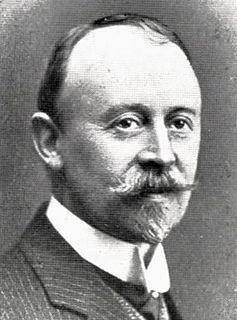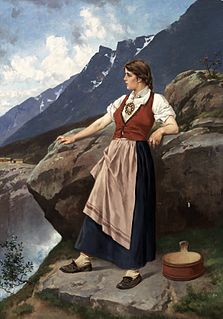Related Research Articles

Utstein Abbey is Norway's best-preserved medieval monastery. It is located on the southern shore of the island of Klosterøy in Rennesøy municipality, Rogaland county. It was built in the late 1200s. Utstein Church is located on the grounds of the abbey.

Hoff Church is a historic church located outside of Lena, Østre Toten municipality, Oppland county, Norway. Hoff Church is associated with the Church of Norway, Østre Toten Parish Council of the Diocese of Hamar which covers Oppland and Hedmark.

Arnstein Rynning Arneberg was a Norwegian architect. He was active professionally for 50 years and is often considered the leading architect in Norway of his time.

Årdal is a former municipality in Rogaland county, Norway. The 558-square-kilometre (215 sq mi) municipality existed from 1859 until 1965. It stretched from the head of the Årdalsfjorden in the west to the county border in the east. It encompassed the southern half of the present-day municipality of Hjelmeland. The administrative centre of the municipality was the village of Årdal where the Old Årdal Church is located.

Jens Zetlitz Monrad Kielland was a Norwegian architect, professor and author.

Andrew Lawrenceson Smith, also known as Anders Lauritzen Smith, was a Scottish craftsman, woodcutter and painter. He was married to Maren Knudsdatter.
Events in the year 1949 in Norway.

Per Ung was a Norwegian sculptor.

Anders Castus Svarstad was a Norwegian painter, most frequently associated with his urban landscapes.

Holmen Church is a parish church located at Prestfoss in Sigdal municipality, Buskerud county, Norway. Access to the church is via Fv133 and Rv287.

Jacob Wilhelm Nordan was a Danish-born, Norwegian architect. During his career, he was one of the most prolific church architects in Norway.
Benny Anette Motzfeldt was a Norwegian visual artist and glass designer and sculptor.

Gustav Adolph Lammers was a Norwegian priest, architect, artist and member of parliament.

Georg Jens Greve was a Norwegian architect.

Karl Uchermann was a Norwegian painter and illustrator. He is best known for his portraits of animals, in particular dogs. He also painted altarpieces, and is credited for designing the world's first franking machine in 1901.

Elias Fiigenschoug was a 17th-century Norwegian Baroque portrait and landscape painter.

Gerhard Fischer was a Norwegian architect and archaeologist.

Axel Hjalmar Ender was a Norwegian painter and sculptor, remembered primarily for his genre painting.

Hugo Wathne was a Norwegian sculptor and art instructor.
Events in the year 1539 in Norway.
References
- ↑ Nina Aldin Thune. "Årdal kirke". Store norske leksikon. Retrieved December 1, 2016.
- ↑ "Utstein Kloster". Store norske leksikon. Retrieved December 1, 2016.
- ↑ Kåre Hosar. "Peter Reimers". Norsk biografisk leksikon. Retrieved December 1, 2016.
- ↑ Henning Alsvik. "Gottfried Anderssøn Hendtzschel". Norsk kunstnerleksikon. Retrieved December 1, 2016.
- ↑ Kjartan Fløgstad. "Anders Smith". Norsk biografisk leksikon. Retrieved December 15, 2016.
- ↑ Sigrid Christie. "Laurits Snekker". Norsk kunstnerleksikon. Retrieved December 1, 2016.